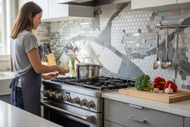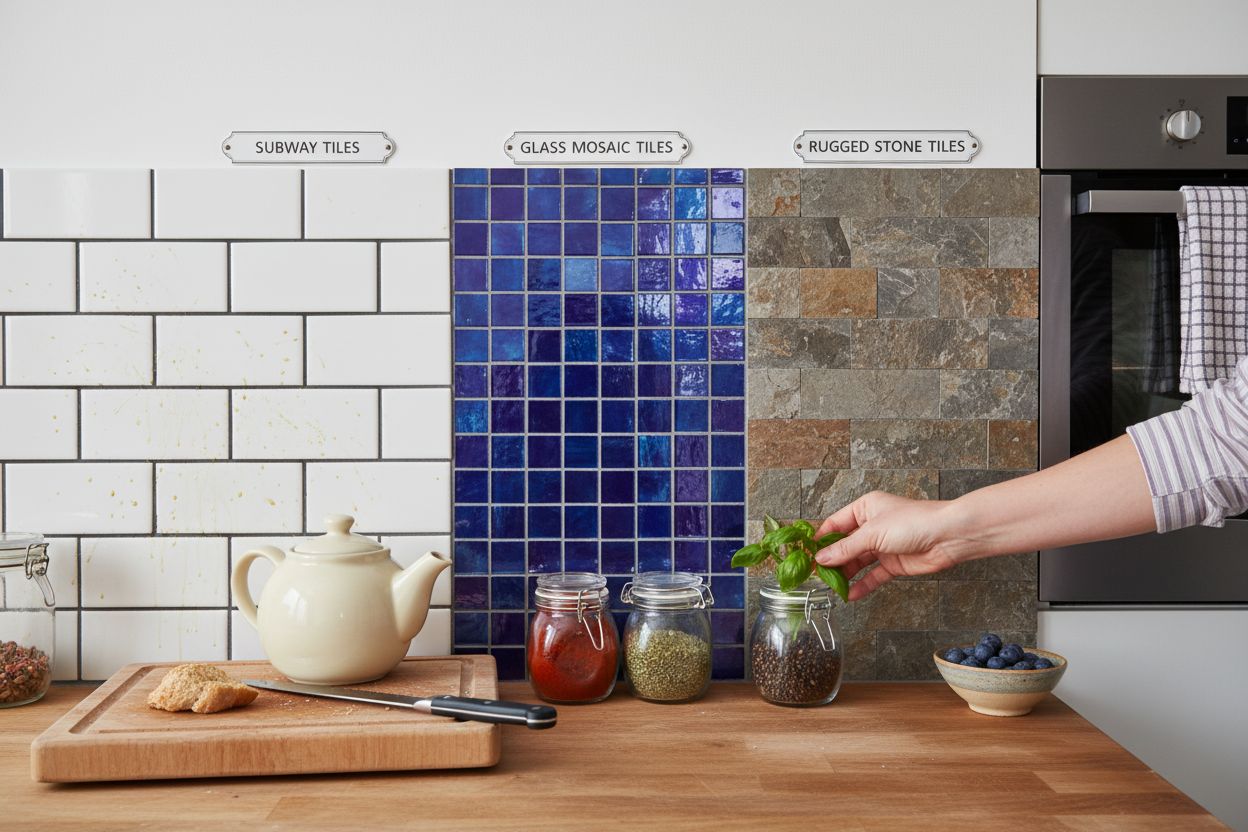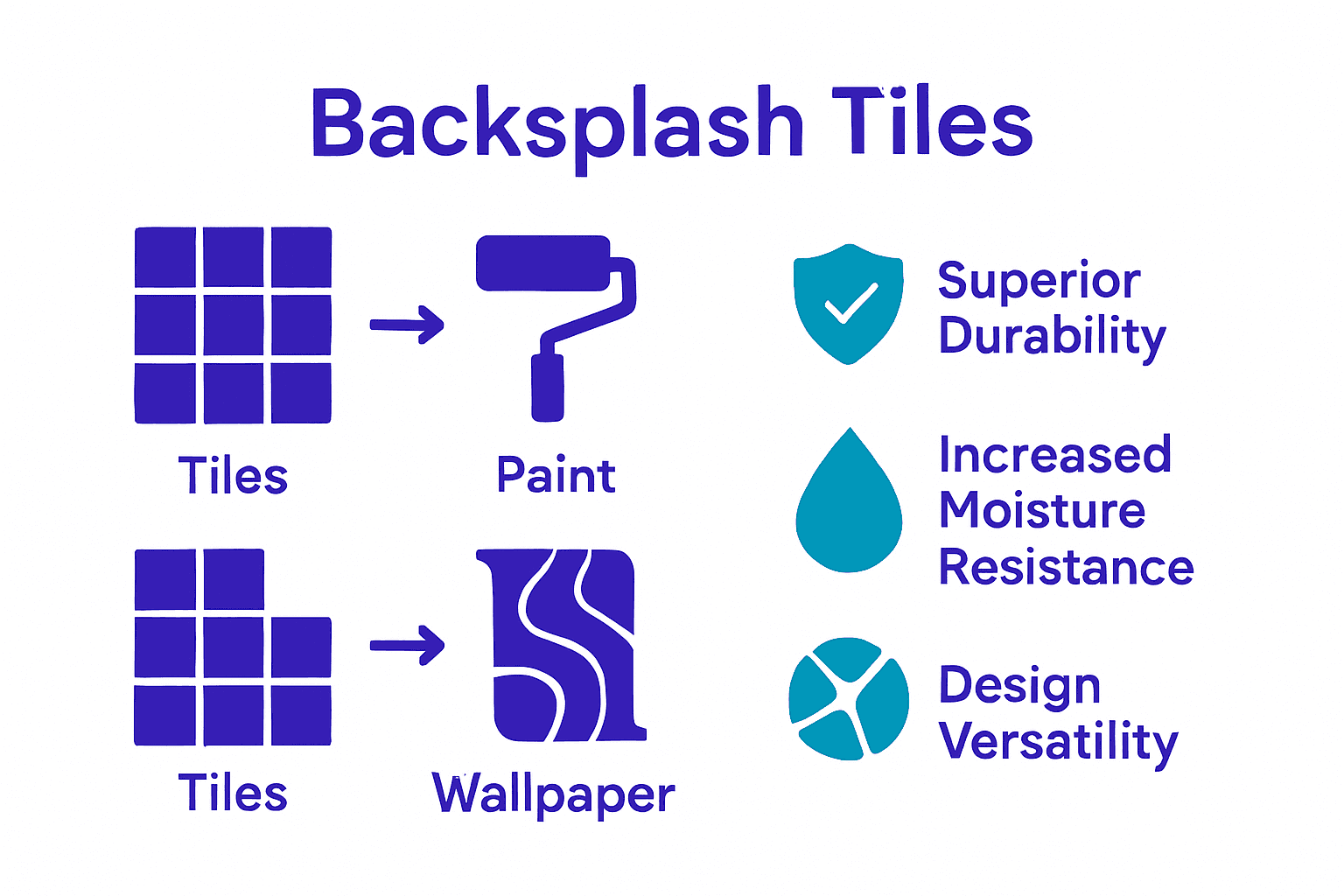Backsplash Tiles: Everything You Need to Know
Posted by Mike Belk on Oct 23, 2025

Did you know that over 70 percent of modern kitchens feature backsplash tiles for both style and practical reasons? Spills, splashes, and steam can quickly wear down unprotected walls, leading to stains and expensive repairs. That is why understanding the purpose and variety of backsplash tiles helps homeowners find the perfect balance of protection and design flair for their kitchen or bathroom.
Key Takeaways
| Point | Details |
|---|---|
| Dual Purpose of Backsplash Tiles | Backsplash tiles protect walls from moisture and stains while enhancing the aesthetic appeal of kitchens and bathrooms. |
| Variety of Materials | Homeowners have multiple tile options such as ceramic, porcelain, glass, stone, and cement, each with unique benefits and aesthetic impacts. |
| Investment Considerations | When choosing backsplash tiles, consider material costs, maintenance requirements, and potential long-term value in home design. |
| Superior Performance | Backsplash tiles offer enhanced durability and design versatility compared to alternative wall treatments like paint or wallpaper, making them a smart investment. |
Table of Contents
- What Are Backsplash Tiles? Core Definition And Purpose
- Types Of Backsplash Tiles And Key Distinctions
- Primary Benefits Of Installing Backsplash Tiles
- Design Versatility And Style Impact In Spaces
- Maintenance, Durability, And Cost Considerations
- Comparing Backsplash Tiles To Alternative Options
What Are Backsplash Tiles? Core Definition and Purpose
A backsplash tile is a specialized wall covering designed to protect kitchen and bathroom surfaces from moisture, grease, and food splatter while simultaneously enhancing the aesthetic appeal of the space. According to research from home design experts, these functional design elements serve a dual purpose of protecting walls and expressing personal style.
Typically installed behind sinks, stoves, and countertops, backsplash tiles create a resilient barrier against daily kitchen activities. As highlighted by research on kitchen design, these tiles shield walls from potential water damage, staining, and wear that can occur during cooking and cleaning. They act as a critical protective layer, preventing moisture from seeping into wall materials and causing long-term structural issues.
Beyond their practical function, backsplash tiles are a powerful design element that can dramatically transform a room’s visual character. Homeowners can choose from an incredible range of materials, colors, and patterns to complement their existing decor. Whether you prefer sleek modern glass tiles, rustic ceramic designs, or intricate mosaic patterns, backsplash tiles offer an opportunity to inject personality into your kitchen or bathroom. Check out our guide on choosing the perfect kitchen backsplash to explore design possibilities that match your unique style.
Key benefits of backsplash tiles include:
- Easy to clean and maintain
- Resistant to water and stains
- Protects wall surfaces from damage
- Adds visual interest and style to the space
- Available in numerous design options to suit any aesthetic
Types of Backsplash Tiles and Key Distinctions
Backsplash tiles come in a diverse array of materials, each offering unique characteristics and aesthetic appeal. According to research from consumer design experts, the most common types include ceramic, porcelain, glass, cement, and stone tiles, each presenting homeowners with distinctive options for protecting and beautifying their kitchen spaces.
Ceramic and porcelain tiles remain popular choices due to their durability and versatility. These materials offer excellent resistance to moisture and stains, making them ideal for high-traffic kitchen areas. Glass tiles, by contrast, provide a sleek, modern look with incredible light-reflective properties that can make smaller spaces feel more open and luminous. For those seeking a more natural aesthetic, stone tiles like granite and marble offer unique patterns and textures that can transform a kitchen’s entire visual landscape.
Each tile material comes with specific advantages and considerations. Stone tiles provide unparalleled natural beauty but might require more maintenance. Ceramic tiles offer affordability and easy cleaning. Glass tiles create stunning visual depth but can be more expensive. Cement tiles deliver industrial-chic looks with remarkable durability. Homeowners should consider factors like budget, maintenance requirements, cooking habits, and overall kitchen design when selecting their ideal backsplash tile.

Here’s a comparison of popular backsplash tile materials and their key characteristics:
| Tile Material | Durability | Maintenance | Cost per sq. ft. | Style Impact |
|---|---|---|---|---|
| Ceramic | High | Low | $2 - $7 | Versatile, Classic |
| Porcelain | Very High | Very Low | $3 - $10 | Modern, Sleek |
| Glass | Moderate | Moderate | $7 - $30 | Reflective, Contemporary |
| Stone | High | Moderate-High | $10 - $50 | Natural, Unique |
| Cement | Very High | Moderate | $8 - $20 | Industrial, Bold |
Key distinctions among backsplash tile types include:
- Ceramic: Budget-friendly, easy to clean
- Porcelain: Extremely durable, low maintenance
- Glass: Modern look, light-reflecting
- Stone: Natural beauty, unique patterns
- Cement: Industrial aesthetic, highly durable
Primary Benefits of Installing Backsplash Tiles
Backsplash tiles offer homeowners a multifaceted solution that goes far beyond simple wall protection. Understanding the key advantages of backsplash installations reveals why they’ve become an essential element in modern kitchen design. These versatile wall coverings provide critical functional and aesthetic benefits that transform both the practical utility and visual appeal of kitchen spaces.
From a practical perspective, backsplash tiles create an impenetrable barrier against moisture, grease, and food splatter. According to home design research, these tiles protect vulnerable wall surfaces from potential water damage, staining, and long-term deterioration. Ceramic, porcelain, and glass tiles specifically offer exceptional resistance to daily kitchen challenges, ensuring walls remain pristine and structurally sound even in high-traffic cooking environments.
Beyond protection, backsplash tiles serve as a powerful design element that can dramatically elevate a kitchen’s aesthetic. Homeowners can choose from an extensive range of materials, colors, and patterns to complement existing decor, effectively adding personality and visual interest to the space. This design flexibility means backsplash tiles aren’t just functional—they’re a statement piece that can significantly enhance a home’s overall visual appeal and potentially increase its market value.
Key benefits of installing backsplash tiles include:
- Superior wall protection against moisture and stains
- Easy to clean and maintain
- Adds visual depth and personality to kitchen spaces
- Increases home’s aesthetic and potential resale value
- Provides design versatility with numerous material options
- Resistant to heat, grease, and daily kitchen wear and tear
Design Versatility and Style Impact in Spaces
Backsplash tiles represent an extraordinary canvas for personal expression, transforming ordinary kitchen and bathroom walls into stunning visual statements. According to design research, these versatile design elements offer homeowners unprecedented creative freedom to craft unique aesthetic experiences that reflect individual style and personality.
Design flexibility is the hallmark of modern backsplash tiles. Exploring tile design options reveals an incredible spectrum of possibilities, from intricate mosaic patterns to sleek, minimalist arrangements. Ceramic, glass, and stone tiles can be arranged in herringbone, subway, geometric, or completely custom configurations, allowing each installation to become a personalized work of art. The ability to mix and match colors, textures, and materials means no two backsplashes need ever look identical.
Beyond pure aesthetics, backsplash tiles serve as powerful design anchors that can dramatically transform a space’s entire visual narrative. A carefully selected tile can either complement existing decor or become a bold focal point that elevates the entire room’s design language. Contemporary homeowners are increasingly viewing backsplash tiles not just as functional surfaces, but as integral design elements that communicate style, mood, and personal taste.
Key design versatility features include:
- Unlimited color and pattern combinations
- Ability to match multiple design styles (modern, classic, industrial)
- Option to create custom visual narratives
- Potential to dramatically transform space aesthetics
- Adaptable to different room sizes and layouts
- Opportunity for creative personal expression
Maintenance, Durability, and Cost Considerations
Backsplash tiles represent a significant investment in your home’s functionality and aesthetic appeal, with maintenance requirements and costs varying dramatically across different materials. Understanding the nuanced economics of tile selection is crucial for homeowners looking to balance budget, durability, and long-term value.
According to consumer research, tile materials like ceramic and porcelain offer the most cost-effective and low-maintenance solutions, typically ranging from $2 to $7 per square foot. These materials provide exceptional durability, resist staining, and require minimal upkeep. Glass and natural stone tiles, while more expensive, offer unique aesthetic advantages but demand more sophisticated maintenance routines. Homeowners should anticipate higher cleaning and potential sealing requirements for these premium materials, which can impact long-term maintenance costs.
The total cost of a backsplash installation extends beyond material prices, encompassing preparation, professional installation, and potential future maintenance. Ceramic tiles represent the most budget-friendly option, with complete installations averaging around $25 per square foot. More exotic materials like hand-crafted glass or premium stone can escalate costs significantly, potentially reaching $50-$100 per square foot. Smart homeowners will consider not just initial expenses, but also expected lifespan, maintenance frequency, and potential replacement costs when making their selection.
Key considerations for backsplash tile investment include:
- Material cost per square foot
- Installation complexity and professional fees
- Expected maintenance requirements
- Durability and potential replacement frequency
- Aesthetic value and design impact
- Long-term performance in kitchen environments
Comparing Backsplash Tiles to Alternative Options
Homeowners today have multiple options for protecting and decorating kitchen walls, but backsplash tiles remain the gold standard for combining functionality and aesthetic versatility. Understanding the comparative advantages of different backsplash solutions reveals why tiles consistently outperform alternative wall treatments.
Compared to painted surfaces, tile backsplashes offer dramatically superior durability and protection.
 Paint can chip, peel, and absorb stains quickly, whereas ceramic and porcelain tiles create a resilient barrier that withstands heat, moisture, and daily kitchen challenges. Glass splashbacks provide a sleek alternative but typically come with a significantly higher price tag and more limited design flexibility. Tiles, in contrast, offer homeowners an incredible range of colors, patterns, and textures that can be mixed and matched to create truly personalized design statements.
Paint can chip, peel, and absorb stains quickly, whereas ceramic and porcelain tiles create a resilient barrier that withstands heat, moisture, and daily kitchen challenges. Glass splashbacks provide a sleek alternative but typically come with a significantly higher price tag and more limited design flexibility. Tiles, in contrast, offer homeowners an incredible range of colors, patterns, and textures that can be mixed and matched to create truly personalized design statements.
Alternative options like stainless steel panels, acrylic splashbacks, and wallpaper might seem appealing initially, but they pale in comparison to tile’s long-term performance. Stainless steel can show fingerprints and scratches, acrylic can yellow over time, and wallpaper is vulnerable to moisture damage. Ceramic and porcelain tiles not only resist these common degradation issues but also add substantial value to a home, making them a smart investment for budget-conscious and design-savvy homeowners.
Key comparisons between backsplash tiles and alternatives:
- Superior durability compared to paint
- More design versatility than glass splashbacks
- Better moisture resistance than wallpaper
- More cost-effective than custom metal panels
- Easier to replace and repair than integrated surfaces
- Adds long-term value to home design
Transform Your Space With Just the Right Backsplash Tile
Are you tired of worrying about moisture damage, hard-to-clean kitchen stains, or walls that just do not reflect your personal style? As discussed in the article, backsplash tiles are not only the best defense against daily wear and tear but also give you a way to express yourself. If you want your kitchen or bathroom to stand out for its durability and beauty, the right tile choice can make all the difference.
Step into a world where quality meets design by browsing the extensive tile collections at BELK Tile. Discover glass mosaics, porcelain, and natural stone options that bring your vision to life. Unsure which style to choose? Let our inspiration galleries guide you or start your search with our kitchen backsplash tiles section for trending ideas. Do not wait to upgrade your home with backsplash solutions designed to last. Explore our full range of tiles now and find the perfect match for your project today.
Frequently Asked Questions
What are backsplash tiles used for?
Backsplash tiles are used to protect kitchen and bathroom walls from moisture, grease, and food splatter, while also enhancing the aesthetic appeal of the space.
What types of materials are available for backsplash tiles?
Common types of backsplash tile materials include ceramic, porcelain, glass, cement, and stone, each offering unique characteristics in terms of durability, maintenance, and style.
What are the benefits of installing backsplash tiles?
Installing backsplash tiles provides superior wall protection, is easy to clean and maintain, adds visual interest and personality to spaces, and can potentially increase a home’s aesthetic value.
How do backsplash tiles compare to alternative wall treatments?
Compared to alternatives like paint and wallpaper, backsplash tiles offer greater durability, moisture resistance, and design versatility, making them a better long-term investment for protecting and beautifying kitchen walls.
Recommended
- 5 of the Best Type of Tile for Backsplash
- 10 Expert Tips for Choosing the Perfect Kitchen Backsplash
- What Everybody Is Saying About Backsplash Tile
- The Finest Collection of Kitchen Backsplash Tiles That Make a Difference
- White Wall Tiles: A Complete Guide to Choosing and Installing Them - – Vivido Tiles



